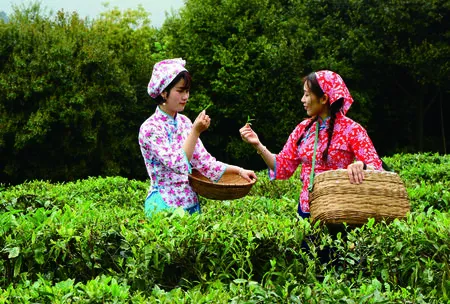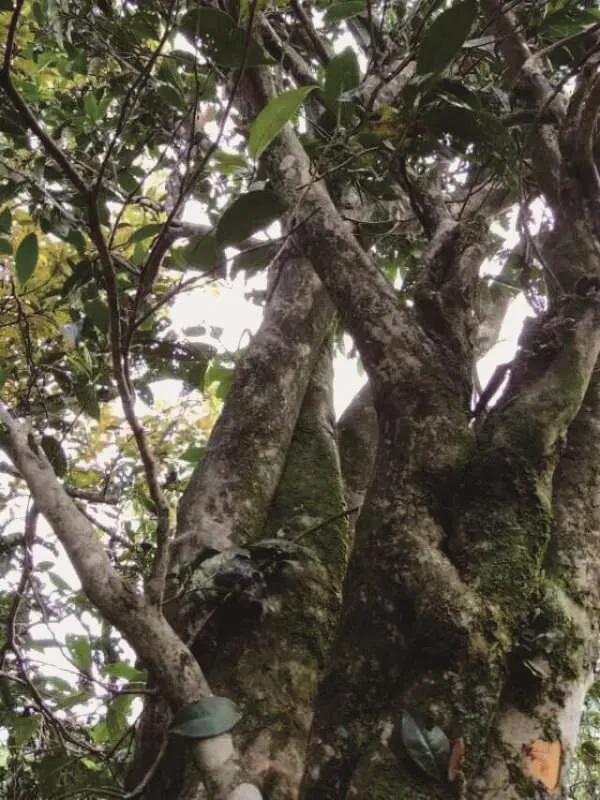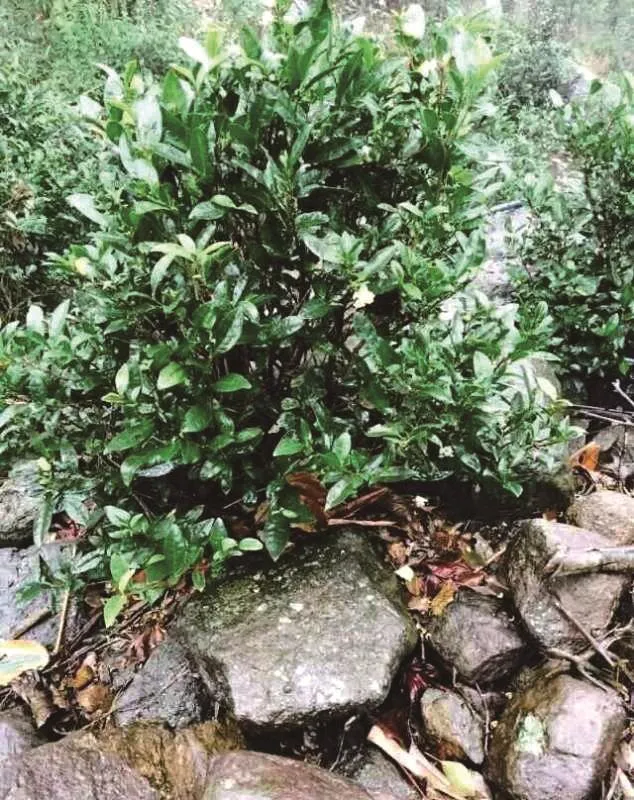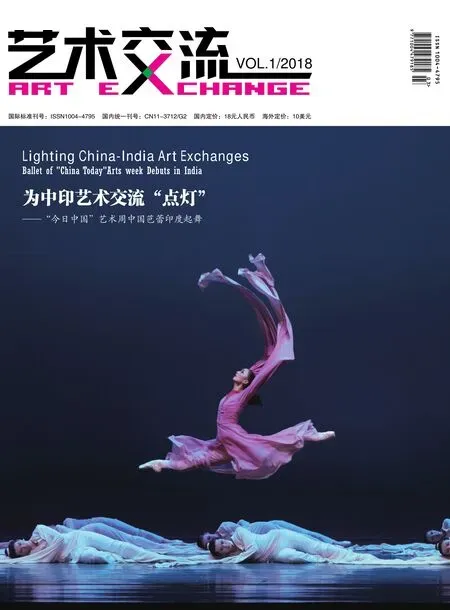粤北茶乡行
2018-07-05刘照丁佟虎LIUZhaodingTONGHu徐进韶坤周伟荣合XUJinSHAOKunZHOUWeiRONGHe
文刘照丁 佟虎 LIU Zhaoding TONG Hu 图徐进 韶坤 周伟 荣合 XU Jin SHAO Kun ZHOU Wei RONG He

粤北韶关市翁源县蓝河村茶园一角A corner at tea garden at Lanhe Village of Wengyuan, Shaoguan City in Northern Guangdong
粤北地处粤、赣、湘、桂四省(区)的结合部,主要包括韶关市和清远市所辖县、区。好山好水出好茶,粤北堪称茶的故乡,目前仅韶关市就有翁源、始兴、乳源等9个县、区在种植茶叶。据权威机构评定,广东省十大茶乡中,粤北就有曲江区罗坑镇、仁化县红山镇、清远英德市上榜,驰名的茶叶品牌有曲江罗坑“雪花岩”高山茶、“猴采红”原生态红茶,仁化红山银毫茶,乐昌沿溪山白毛茶,清远英德红茶等。这些上好的茶叶,以其悠久的历史、优良的品质和独特的芳香吸引着天下来客。
早春二月,春寒料峭。我们驱车向曲江区罗坑镇出发。罗坑镇位于韶关市区的西南部,南接清远英德市英红镇和横石塘镇,是粤北著名的茶乡。驱车一个多小时后,我们便进入了该镇政府所在的位置,只见这里大山怀抱,竹木成荫,溪水潺潺,没有一丝工业的痕迹。放眼附近的村寨,似乎被早春唤醒了似的,村前屋后的画眉鸟叽叽喳喳叫出欢悦的和鸣声,植物在经历寒冬后悄然吐出新芽,远处高山冒出的雾气缭绕山梁如诗如画,大地显出勃勃生机。
在罗坑镇的村前屋后,随处可见精美的茶文化招牌。这里从古至今就是茶乡,近年来在这里发现的上万棵古茶树和至今仍然延续的浓郁的茶文化就是例证。据该镇有关负责人介绍,该镇辖区面积218平方公里,森林面积32.5万亩,森林覆盖率86%以上,已建立国家级自然保护区。以往,罗坑镇以传统种植业和家禽饲养业收入维持温饱。改革开放后,该镇积极探索“一乡一品”的经济发展模式,一些群众便利用祖上传下的技术开始走了种茶制茶的发展路子。近年来,该镇群众在种茶制茶过程中发现了崇山峻岭中深藏的古茶树,这一惊人发现引发了该镇经济发展的新思考。经普查,目前该镇已发现上百年的古茶树12000多棵。为此,他们一方面按照自然保护区的要求加强对古茶树的保护,另一方面请有关专家开展对古茶树的研究。目前,该镇发展茶园面积达到8800多亩,茶生产企业有20多家。该镇从事茶叶种植、生产、加工、销售人员有3600多人,占全镇总人口1/3以上,茶农仅此一项人均纯收入近两万元。实践再次证明,绿水青山就是金山银山。
曲江茶历史悠久,在曲江区罗坑镇,随处可听到喝茶人讲茶史。据供职于曲江区文联的晏保权介绍,《中国茶叶大辞典》就春秋时期齐国贤相晏子(名婴)对茶的研究进行了考辨,晏子堪称“先古第一茶人”,亦称为“茶祖”。罗坑镇先祖对“茶祖”崇拜有加,在该镇新屋村旁,就曾经造有供奉“茶祖”的庙。又据唐代“茶圣”陆羽《茶经》记载:“岭南茶产于韶州”,其所记载的韶州茶,经考证就属于曲江茶。《广东通志》引《韶州志》:“细茶出南华者佳。”南华即为现今的曲江区。《曲江乡土志》记载:“茶叶树,其类甚多。其叶可煮茶,以南华、罗坑味甜香浓,经宿不变者为美。”这些史料说明,曲江区南华、罗坑等地,早在一千多年前就是茶乡。
据介绍,罗坑镇的茶叶之所以味甜香浓,泡后经隔夜仍不变色不变味,得益于这里独特的环境气候。这里属亚热带季风型气候区,昼夜温差较大,日照时间长,降雨量丰富。保护区内有大小溪流18条,汇入罗坑水库,保护区地形地貌复杂,山峦重叠,沟壑纵横,森林茂密,自然资源丰富,动植物种类繁多。境内发现的古茶树群,正是保护区内山陡险峻,蛇蜥繁多,众人惧怕才得以保存下来的。
广东省茶业协会理事赖国清向我们讲述了他对茶的感悟:“雪花岩”高山茶源自唐代中期,茶叶采自海拔500米至1200米的高山森林,具有与众不同的“木甜杏仁香”和“木甜花香”。这使我们想起流传于粤北山区的一首采茶歌:“太阳升上半山坡,林中小鸟未出窝,小伙采茶上山去,打着赤脚唱山歌;人人肩头一挂箩,穿过森林渡过河,远望古茶参天擎,未攀茶树喜心窝……”正当我们沉浸在小伙子欢快采茶的情景中时,赖国清已为我们泡上了色泽清纯的“古树杏仁香茶”。我们端茶细细品尝,果然浓醇鲜爽,润人肺腑,让人愉悦无比。
在罗坑镇坪岗岭“猴采红”茶业公司,曲江区罗坑茶行业协会会长何放平介绍了罗坑茶采茶制茶过程中融入中华文化元素的做法。他说,罗坑镇的大山中,有一山峰望似灵猴,故名“猴寨峰”,相传有一对夫妇隐居于此,礼佛茹斋,善待生灵,平时靠采峭壁岩茶的收入清淡度日。年复一年,夫妇渐老,梅花仙子感念其德行,遂化作灵猴陪伴左右,为其攀岩采茶。故事感动了世人,人称其茶为“猴采茶”。
罗坑茶中“古树雅韵”“古树神韵”“蟠桃杏仁香”和“古树古韵”四道茶皆有可观品之处。这四道茶,外表看均是汤色金黄透亮,但细细品茗,却别有韵致。“雅韵”温顺柔和,味纯细腻;“神韵”滋味甘醇富足,韵味鲜爽突出;“杏仁香”香气飘扬,浓郁大气;而“古韵”则味醇厚韵,生津回甘。这四道茶,很像中国古代西施、王昭君、杨贵妃、貂蝉四大美女的性格。
“洁性不可污,为饮涤尘烦;此物信灵味,本自出山原……”告别茶桌,外面已是细雨霏霏。品茶至此,大家已是神清气爽。远眺山峦处飘逸的雾海,我们以为那便是茶乡飘出的香气凝聚,随着那香气,茶乡仿佛已置身于仙界。

翁源县蓝河村采茶姑娘在采茶Tea picking by tea girls at Lanhe Village of Wengyuan
As a junction of Guangdong, Jiangxi, Hunan and Guangxi provinces, the Northern Guangdong Area mainly includes Shaoguan City and counties and districts under Qingyuan City. Great mountain with pure water and fine-quality tea, the region is called the hometown of tea. At present, only in Shaoguan City, tea cultivation occurs in nine counties and districts,such as Wengyuan, Shixing, Ruyuan and others. According to the assessment by the authority, the Northern Guangdong Area,amongst all the ten tea villages in Guangdong Province, includes Luokeng Town of Qujiang District, Hongshan Town of Renhua Disctrict and Yingde town of Qingyuan City, showcasing some well-known tea brands, such as Snowflake Rock high mountain tea from Luokeng of Quyuan, original ecological black tea of Houcaihong, Yinhao tea of Hongshan, Renhua, white-hair tea of Yanxishan, Lechang, and black tea of Yingde, Qingyuan. These top-quality teas, with their long history, excellent quality and unique aroma, attract visitors from around the world.
In early spring, February, it still felt quite chilly. We drove to Luokeng Town of Qujiang District. Located in the southwest of Shaoguan City, the little town, adjacent to Yinghong Town and Hengshitang Town of Yingde City of Qingyuan to the south, is a famous tea village in northern Guangdong. After more than onehour driving, we entered the location of the town government,where I saw the embrace of the mountains, shady trees and gurgling streams without any trace of industry. Looking around the nearby village, it seemed that it has been awakened by the early spring with the thrushes’ pleasant songs by houses, the plant quietly spit out the sprouts after the winter, the misty mountains surrounded by smoke in distance were picturesque showing great vitality of the land.
Exquisite signs of tea culture could be found everywhere in Luokeng Town. This place has been the tea village since ancient times, tens of thousands of ancient tea trees found in recent years and the strong tea culture continued at present time are the effective proof. According to the people in charge of the town, covering the area of 218 square kilometers, the forest area of 325,000 mu and over 86% of forest coverage, the town has established a national nature reserve. In the past, the Luokeng Town maintains adequate food and clothing with traditional farming and poultry. After the reform and opening up, the town actively explored the economic development model of "one county, one product",and some people began to take the development path of tea plantation by using the technologies passed from their ancestors. In recent years, the town people found ancient tea trees in the mountains in the tea growing process, this amazing discovery triggered the new thinking of the town's economic development. More than 12,000 strains of ancient tea trees over a hundred years have been found after census.To this end, on the one hand, they are required to strengthen the protection of ancient tea trees in accordance with the requirements of nature reserves. On the other hand, relevant experts are invited to conduct research on these ancient tea trees. At present, the town has reached 8800 acres of tea garden area and more than 20 tea production enterprises.More than 3600 people from the town are engaged in tea cultivation, production, processing and sales, accounting for 1/3 of the town's total population. And tea farmers received a per capita net income of nearly 20,000 RMB through this item only. Practice once again proves that lucid waters and lush mountains are invaluable assets.

罗坑深山枝繁叶茂的古茶树Flourish ancient tea trees in deep mountains at Luokeng Town
Qujiang tea enjoys a long history. Tea drinkers’ telling history of tea can be found anywhere in Luokong Town, Qujiang District. According to YAN Baoquan, who works in Qujiang federation of literary and art circles,Dictionary of Chinese Teaexamines the study of tea by Qi Dynasty’s renowned chancellor YAN Zi (Style name as YING) from the Spring and Autumn Period. YAN Zi is accordingly regarded as "the first man of tea in ancient times", known as the "tea ancestor".Luokeng Town’ ancestors worshipped the "tea ancestor", as a temple dedicated to the "tea ancestor" has been built near the Xinwu Village of the township. According to the records ofTea Scriptureof LU Yu, the Saint of Tea in Tang Dynasty:"Lingnan tea is produced in Shaozhou", the Shaozhou tea in the records belongs to the Qujiang tea through thorough research.Guangdong AnnalsquotedShaozhou Archives:Nanhua produced the best Dust tea. Nanhua is the Qujiang District at present.Records of Qujiang Archivesshow: "Tea trees are of many kinds. The leaves can be brewed, with those of strongest sweetness and fragrance produced Nanhua and Luokeng, and the most superb remains unchanged through night." These historical facts show that area like Nanhua of Qujaing District, Luokeng and others were the villages of tea as early as a thousand years ago.
According to the reports, the tea sweetness and fragrance with unchanged color and flavor after soaking overnight from Luokeng Town were due to the unique climate here. It belongs to the subtropical monsoon climate zone, showing large temperature difference between day and night, long sunshine and abundant rainfall. There are 18 streams in the reserve, which are imported into Luokeng Reservoir. The protected area demonstrates complicated terrain, overlapping hills, ravines, dense forests, rich natural resources and a great variety of animals and plants. The ancient tea tree groups found in the area are under fine protection accordingly thanks to its steep location and large number of snakes and lizards around, driving people away.
LAI Guoqing, director of the Guangdong Tea Industry Association, told us about his sentiment about tea: "Snow Flake" high mountain tea originated from the middle of the Tang Dynasty. Tea was collected from alpine forests at locations 500 to 1,200 meters above sea level, bearing unique woody almond sweet and woody flower sweet. This reminds us of a piece of tea song circulating in the mountains of northern Guangdong: "The sun rises halfway up the hill, birds still rest in nest, a young man climbing hills to collect teas with bare foot while sing folk songs; everyone shoulders a hanging basket, crossing forests and rivers and looking at the ancient tea trees in distance with happiness in heart…" As we were immersed in the young man's cheerful tea picking scene, Mr.LAI Guoqing had already soaked us the "almond tea of ancient trees" showing pure and simple color. We carefully tasted the tea, finding it refreshing and cool with moisture, endowing people with unprecedented joy.
At the Pinggangling Houcaihong Tea Company in Luokeng Town, HE Fangping, chairman of the tea association of Qujiang District has introduced the methods of integrating elements of Chinese culture into the tea picking and processing. He said that a mountain was shaped like a monkey in Luokeng Town, winning the name of Hou Village Peak. Legends said that a couple lived here in seclusion, showing their devotion by abstaining from meat and praying to Buddha and kind of all life, having a simple life by income from selling rock tea. Year after year, the couple was getting older. Plum fairy read their virtues, and then transformed into a monkey to accompany the old couple, climbing rocks to collect rock tea for them. The story has touched the world, hence the tea is called Houcai Tea.

罗坑镇古茶籽自然繁殖的新茶树New tea trees naturally bred by ancient tea seeds at Luokeng Town
Four types of tea of Luokeng Tea as Gu Shu Ya Yun, Gu Shu Shen Yun, Pan Tao Xing Ren Xiang and Gu Shu Gu Yun are of most high quality in admiration and taste. The four teas all show the golden color with translucency in soup, but remain differently charming in taste. "Ya Yun" is gentle and soft with pure and delicate taste; "Shen Yun" is full of sweetness,highlighting the fresh and prominent flavor; "Xing Ren Xiang"spreads fluttering aroma with strong nobility; "Gu Yun" shows strong and pure taste with sweetness and moisture. The four types of tea are much like the characters of four beauties in ancient China, Xishi, WANG Zhaojun, YANG Guifei and Diaochan.
Cleanliness for wiping out troubles; spiritual tastes of nature originate from mountains. Farewell to the tea table, it was already drizzling outside. We were all most refreshed after enjoying tea at this point. Overlooking the mountains at the elegant sea of fog, it occurred to us as if that was the fragrance of tea floating out, and with that aroma, the tea village seemed to be sitting in a fairyland.
